In the marketplace, which parts constitute an “official” LEGO® minifigure? Opinion
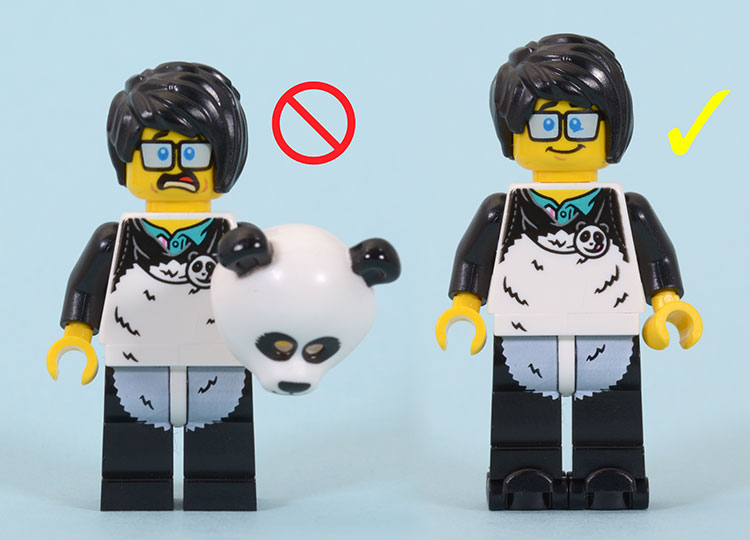
Back when I was in college, my Art Aesthetics class professor asked what was the definition of a realist, and idealist, and a pragmatist. He explained the difference this way: If a tree falls in the forest and there is no one there to hear it, is there any sound? The realist says “yes”, the idealist says “no”, and the pragmatist says “what difference does it make?”
A member on the BrickOwl forum recently posted a question as to why the minifigure part assemblies on BrickOwl did not necessarily match those on Brickset, Rebrickable, or BrickLink.
Apologies now for the upcoming nerdgasm.
The situation is a can of worms that may or may not ever be dealt with. The core of the issue is that the information source varies from platform to platform and the LEGO reseller world is largely subject and beholden to the dated idealist structure of the BrickLink catalog. And this isn’t to bash BrickLink, but to recognize that BrickLink has so many tentacles and threads into so many other sites that it is going to be difficult to disentangle and disengage everything from the cross referencing of general nomenclature to the collective community zeitgeist because BrickLink has been a dominant force in the AFOL community for so long.
A database from the dark ages
That said, BrickLink’s architecture hasn’t kept up with the progress of the product it catalogs. The database structure is idealist: one peg fits one hole. Available fields can contain one and only one possible value. A piece is a this or a that. No piece can be a this AND a that. This leads to problems with discovery. The BrickLink forum is littered with “what is this part” questions that have to be answered by someone who knows where to find it. A person posting writes “I searched under engine category and cone category and plate modified category” and they are rightly surprised to find that the part is cataloged under “wing” category. And in BrickLink world, the answer to that problem has at times been to debate rage about it in the forum, then move it to engine, then to cylinder, then to plate modified, then to wing, rinse and repeat. With a more flexible database available, the pragmatist and the realist would list the part under each appropriate category. With the idealist database the catalog administrator struggles and struggles to find the perfect single placement. Because the perfect single placement must exist. Because there is only single placement available.
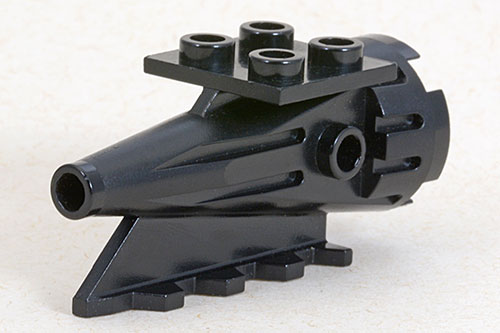
Under which category is this part located this week?
Another case is that there is no capacity in BrickLink’s database for a part to be of multiple colors. For example, the catalog knows the part as “red” and then it has “with black marbling” as part of the item’s title. One cannot find the part searching for a black piece, but can find the part searching for a red one. Parts that predominantly appear to be one color will be arbitrarily assigned one of the catalog’s fixed colors, even though in reality the part may be a swirl of many colors.
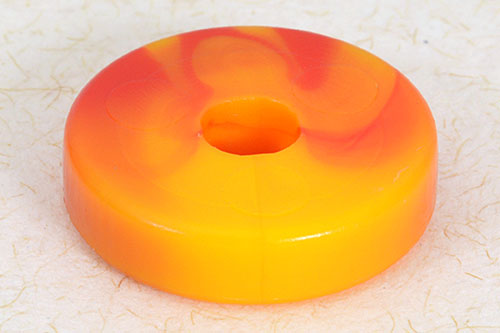
Coloring on this part varies from piece to piece.
Is this piece yellow? orange? red?
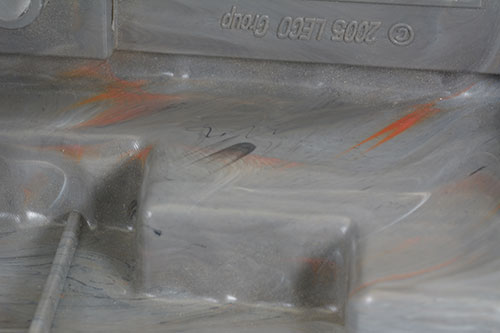
Subjectively, this piece is gray. Objectively it is a swirl of black, white, orange, and grays.
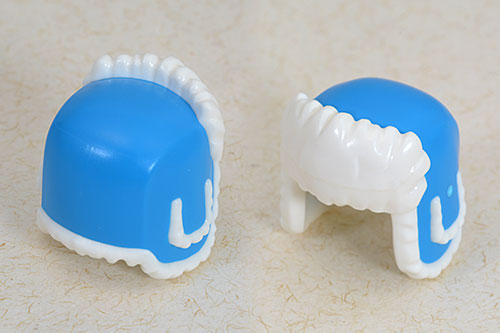
Is this hat white or blue? It is both, is it not?
Rules no newbie knows
We’ve looked at some database shortcomings, now we look at BrickLink rules. BrickLink makes use of extensive convoluted written and unwritten rules to manage the database because the structure is idealistic and exclusive in nature. Relative to minifigures, there are two rules of configuration that seemingly are at odds with one another. First is the “hand held item” rule. Hand held items are deemed to not be part of the figure. This makes some sense for weapons, but not necessarily for things like werewolf claws or “big fists”. The hand held item rule is in direct contrast to the “attached to the foot rule” which requires part attachment to the feet: bricks, flippers, skates, and so on. These attachments are considered part of the figure, and without these attachments the figure is deemed incomplete.
Until fairly recently, at least as far as I know, a minifigure had one assembly configuration, defined in the set instructions, per set. The figure may have had an optional hat/hair swap, and via BrickLink’s rules whichever headpiece showed up first in the instructions became the de facto iteration of that figure. Lately we have seen sets where the figures may be composed in multiple ways. For example, Set 31119 Creator Ferris Wheel has three separate instruction books and three separate, distinct assemblies for five figures. Book 1 assembles the figures one way, and books 2 and 3 assemble them in different ways. The books are not numbered 1, 2, 3, so there is no definite priority in actual assembly. There may be a perceived implied importance given that the set is called Ferris Wheel and one book contains instructions to build Ferris Wheel, but who is to say? The point of LEGO is to make your own stuff however you want, right? BrickLink uses the assemblies shown in the Ferris Wheel book as the “official” minifigures for that set. Other minifigure assemblies apparently are “unofficial” even though they are described in the instructions. Realistically and pragmatically these alternate assemblies should be equally valid as the chosen ones, but the idealistic BrickLink database can’t cope.
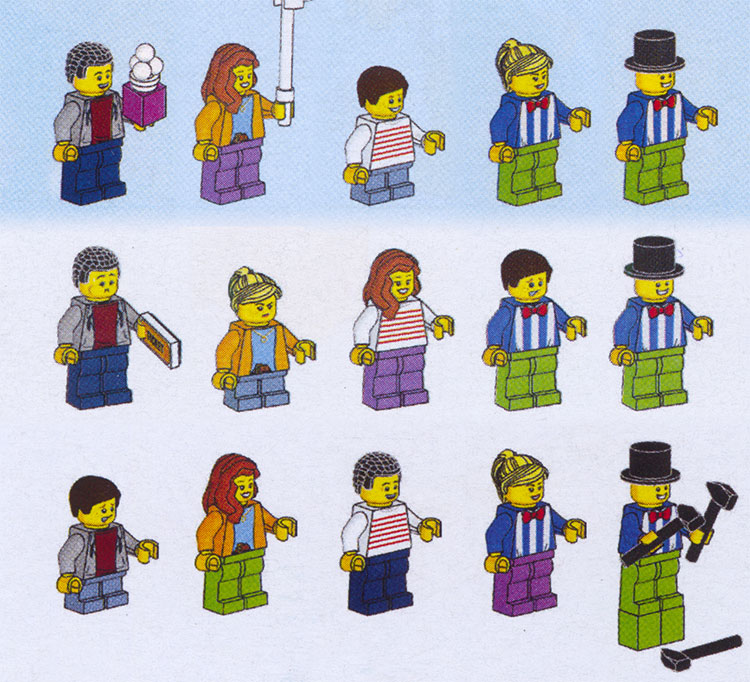
The 31119 minifigure assemblies.
Top row: Ferris Wheel build. Middle row: Swings build. Bottom row: Bumper Cars build.
Parts are the same, except when they’re not
Let’s look at a couple different minifigure parts.
Skeleton torsos display differences. Part 60115 was remolded somewhere around 2013. The older version has a thin bar in the crotch and the newer version has a thick bar in that position. If you view multiple YouTube videos on set 75005 you can see that skeletons have the thick bar version in some reviewers’ sets while other reviewers’ sets contain the thin bar version. So, what is ostensibly one minifigure in the catalog is actually composed of different parts. For this part, BrickLink has a note about the differences, but for the collector it is not immediately apparent that if they want a vintage pirate skeleton, they need to search out the earlier torso. In fact, many sellers may not even be aware there is a difference; the catalog does not reflect this.
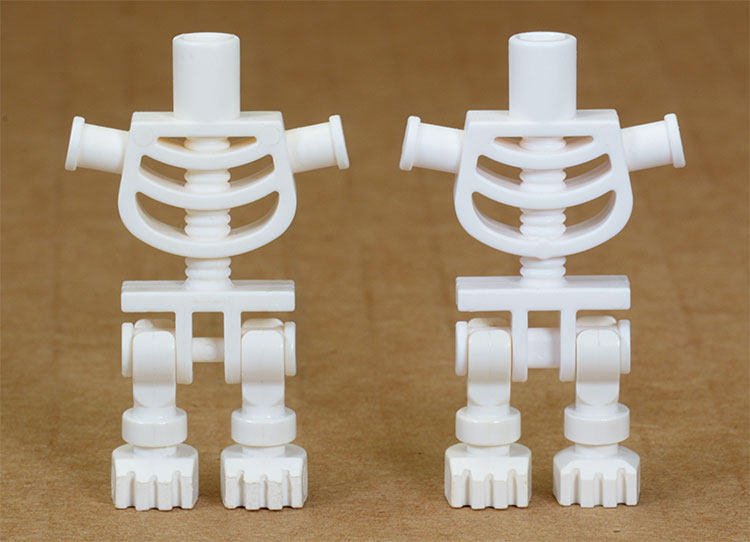
Skeleton torsos. Left: older thin crotch bar version. Right: newer thick crotch bar version.
Minifigure heads display differences. There are at least five versions of the minifigure head: one solid stud with a smaller head edge profile radius, one solid stud with greater head profile edge radius, one with hollow stud with an open bottom and Y-shaped obstruction, one with hollow stud with a solid bottom, and one with hollow stud with open bottom and I-shaped obstruction. At BrickLink these are cataloged as 3626a (both solid stud versions), 3626b (Y-stud), 3636c (solid bottom), and 28621 (I-stud). The heads get additionally complicated with alternate numbers 30011 (abc) and 88475 (c). The two solid stud versions are known, but not separated or noted in the catalog to my knowledge.
There are additional heads, those found on “gear” like pens and keychains, which are of different composition and otherwise ignored or neglected by the catalog, probably because these parts aren’t supposed to be separated from their factory assemblies, but are occasionally found in mixed bulk lots.
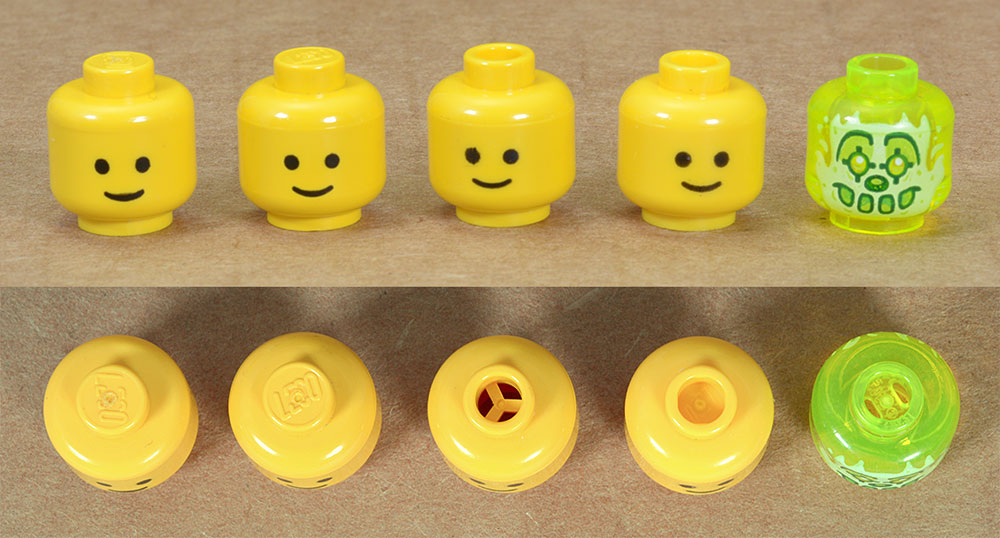
Minifigure heads. L to R: Solid stud smaller radius profile, solid stud larger radius profile, Y-stud, solid bottom, I-stud.
Using the above two parts as an example highlights inconsistencies in the BrickLink cataloging methodology, given that the torsos have one catalog number and a note for two distinct molds, the 3626a heads have one catalog number and no note for two distinct molds, the heads have 3626 a-b-c variants, alternate numbers, and a separate number…so four numbers (or three numbers, or eight numbers, depending on how one looks at it) for five distinct molds. The cataloging goes awry, from an idealist’s standpoint, when a head that is actually a 30001 is listed as a 3626…and depending on LEGO’s available backstock of parts at any given time, a set may ship with either a 3626 OR a 30001 OR an 88475 and technically any of those could and should be correct for a given minifigure.
Unfortunately, these actual variations of configuration combined with a single, fixed, possibly inaccurate or arbitrary marketplace reference can send us down the rabbit hole where some collectors get their panties in a bunch and twist their hair out, newbies can be confused and sometimes intractably adamant, and others are indifferent as to which head they receive and which head they should have received when purchasing from a marketplace. And welcome to seller hell.
Getting back to what defines an “official” figure, why are the figures as shown in the 31119 Swings and Bumper Car builds not “official”? Because BrickLink’s catalog database isn’t built to accommodate it. The answer to pretty much every question regarding potential variations in “official minifigure assembly” is that BrickLink’s catalog isn’t built to accommodate it. At the same time we should note that LEGO, after all, is shipping sets with different “equivalent” parts. I’ll bet you a sprinkle-topped doughnut that the concept of “equivalent parts” was never imagined when the site was initially architected. And it was unfortunate that the previous owner of the site chose to become a slumlord instead of a steward of the platform.
What I would hope to see in the future is a marketplace catalog structure that can accommodate the “purist” collector as well as offer diverse opportunities for sellers. It would be wonderful if an expanded structure found its way throughout the community, but BrickLink is probably going to be the leading edge, for better or worse.

The assembly of Fire Arm shown on the box cover (left) makes some sense, the assembly shown in the instructions (right) really doesn’t.
With regards to minifigures specifically, there probably needs to be a line somewhere defining “official” minifigures…perhaps being anything that is shown in instructions or on box art…which of course raises other issues as sometimes neither the instructions nor the box art accurately reflects the contents of the set…but while considering those boundaries there ought to be some broad leeway with regards to seller-side opportunities and more understanding and acceptance on the buyer/collector side. I would further argue that some common sense be brought to bear in decision-making instead of strictly adhering to some dogma. Maybe the defining line is a little fuzzy.
I would propose a solution in that marketplace database structures become more robust and consider the minifigures in sets as parts only, with alternate equivalent parts. In a separate database table, related minifigures could be composed in various ways–with and without accoutrements, with helmet or hair or hat–and each entry could be distinguished as a “collector’s canon” or an “authorized alternate”. This should provide more opportunity for sellers and less hand-wringing and hyperventilation over minutiae, provided there is adequate documentation, buyer-seller communication, and education. It further removes impediments in the purchasing process. A buyer would be able to buy a Wolverine with claws as opposed to having to buy Wolverine figure from one store, then having to scout claws as a separate lot or order. Changing the marketplace language from “this minifigure is found in these sets” to “this minifigure can be assembled from pieces found in these sets” alters one’s perception from being an absolute to a possibility.
I am fairly sure that catalog team members at BrickLink are aware of the issues with catalog inconsistency, but are kept from resolving the issues due to time, database architecture, politics, or any or all of the aforementioned. Potentially, hopefully, there is some room for movement and new thinking relative to the catalog at BrickLink as the new management team seems to be willing to listen, which is something that really hasn’t happened in the last eight years. Creating a robust platform that will be flexible and adaptable to the needs of the realist and pragmatist sellers and satisfy a more stringent criteria of the idealist hardcore collector, while being acceptable to all in between will take a lot of planning and hard work, but it can be done. The most difficult part will probably be in convincing those people with preconceived notions of “how things should be” and “how things have been” that different ways are viable and, possibly, are superior paradigms.
33502